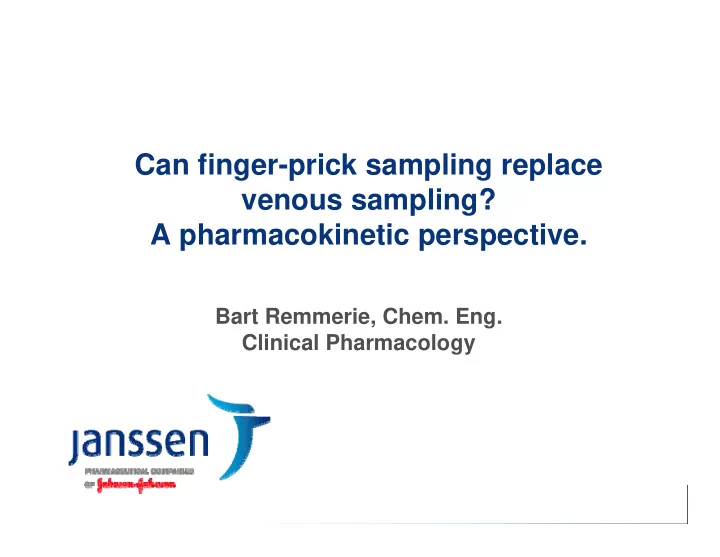

Can finger-prick sampling replace venous sampling? A pharmacokinetic perspective. Bart Remmerie, Chem. Eng. Clinical Pharmacology Bart Rem m erie
Outline • Pharmacokinetic aspects related to blood PK • Cases • Pharmacokinetic aspects related to fingerstick sampling • Conclusions Bart Rem m erie 1
Pharmacokinetic considerations as to when to use dried blood spot sampling M. Rowland & G. Emmons, Bioanalysis 2 (11), 1791-1796, 2010 The unbound concentration as driving force for pharmacokinetics and pharmacodynamics = C C f plasma * u u 1 - H ] = + C C H x R /[ u blood f u W hole Blood ( unbound) concentration is sensitive to •Hematocrit H •Unbound fraction fu in plasma • Ratio R of blood cell concentration-to-unbound concentration in plasma water, which can change, e.g. due to saturation of binding affinity in red blood cells, binding to platelets, … Bart Rem m erie 2
Application of DBS-LC-MS/MS to Geno- and Phenotyping of P450 enzymes. De Boer T, Wieling J, et al. Biomed. Chromatogr. 25 (10): 1112-1123, 2011 Single Dose, Healthy Volunteers ( N= 1 2 ) Venous blood ( DBS, blood, plasm a) Finger puncture ( DBS) Conclusion DB: DBS suitable for PK analysis and Genotyping Conclusion BR: DBS overestim ates reference procedure; Finger puncture blood concentration > venous blood concentration, m ay be adequate for TDM. Bart Rem m erie 3
Internal case 1: study design • Objective: evaluate feasibility finger-prick derived blood for TDM • Parallel-group (N= 5) • Single dose, N= 12 healthy volunteers per treatment group • Extensive PK sampling (total < 122 mL): – Venous blood and plasma (total: 3 mL/sample) – Fingerstick blood and plasma (total: 0.5 mL/sample) Bart Rem m erie 4
Compound O 8 7 6 5 4 Fingerstick plasma 3 Venous plasma 2 1 0 0 20 40 60 80 100 120 Time (hours) Conclusion: Fingerstick plasm a overestim ates venous plasm a for com pound O Bart Rem m erie 5
Ratio fingerstick/ venous plasma versus time Conclusion: Fingerstick plasm a overestim ates venous plasm a for com pound O Bart Rem m erie 6
Ratio fingerstick/ venous plasma versus time Conclusion: Fingerstick plasm a = venous plasm a for com pounds A and D ( except for first hours?) …. Bart Rem m erie 7
Ratio fingerstick/ venous plasma versus time … how ever, fingerstick plasm a m ay overestim ate venous plasm a in som e individuals Bart Rem m erie 8
Case 2 • Single Dose, cross-over study (25, 50, 100 mg dose), fasted • Matrices collected: – Venous plasma (LCMS) – Venous blood (LCMS/DBS) – Fingerprick blood (DBS) • F abs : 75% • V d : 2.6 and 2.9 L/kg • PPB: 20% • T max : 12h ; T 1/2 : 9h Bart Rem m erie 9
Case 2 (highest dose) Plasma Whole Blood DBS Venous DBS Capillary 120 100 80 60 40 20 0 0 5 10 15 20 25 30 35 40 45 50 Time (Hours) Conclusion 1 : DBS overestim ates reference m ethod Conclusion 2 : Fingerstick blood > venous blood concentrations Bart Rem m erie
Case 2: ratio fingerstick/venous versus time Bart Rem m erie 11
Case 3 • Single Dose, parent drug and metabolite measured • Matrices collected: – Venous plasma – Fingerstick plasma – DBS (fingerstick) • Fabs: 52% • Vd: 0.34 L/kg • PPB: 96.3% • Tmax: 2-5h ; T1/2: 1.3h Bart Rem m erie 12
Case 3 (parent drug) Conclusion: Fingerstick plasm a > venous plasm a concentrations Bart Rem m erie 13
Case 3: metabolite Conclusion: Fingerstick plasm a > venous plasm a concentrations Bart Rem m erie 14
W. L. Chiou. The phenomenon and rationale of Marked Dependence of Drug Concentration on Blood sampling Site. Clin Pharm. 17 (3) 1989 • 40+ examples • Mechanistic hypothesis – f= 1-(0.693* R/ (t 1/ 2 * Q)) with, – f= arterial/ venous concentration ratio – R= apparent partition coefficient tissue/ venous blood – Q: blood flow • “… virtually all compounds of clinical interest… will be more or less affected by the sampling site chosen.” • “… marked arteriovenous differences can exist for hrs or days… ” • Initial distribution vs. elimination phase Bart Rem m erie 15
Potential reasons for dissociation • Physiological • Drug-related – Initial contamination with – High (first-pass) extraction? interstitial fluid? – High V d / R? – Effect of stimulation? – Small, lipophilic molecules, – Location distinct from arm? neutral at pH= 7.4? – Capillary blood more reflective – Related to duration of of arterial blood? absorption? – Extraction (Cl/ V) of drug by – Multi-factorial? surrounding sampling tissue? – Effect of blood flow? Bart Rem m erie 16
Final comments & conclusions • Plasma-based PK may be more directly related to PD • Fingerstick based drug levels can overestimate venous plasma levels • Bias especially observed after SD (less at SS?) • Adequacy depends on objective (S.D., M.D., TDM) • What about PD parameters, biomarkers? • Consistent data across/between studies requires consistent methodology • Evaluate consequences of methodological change for project Bart Rem m erie 17
Acknowledgements • Achiel Van Peer • Joris Vandenbossche • Jeike Biewenga • All bioanalytical colleagues involved Bart Rem m erie 18
Q&A Bart Rem m erie 19
Recommend
More recommend